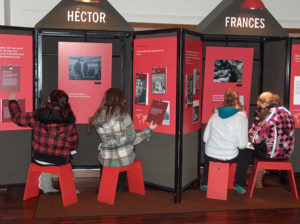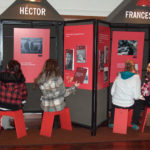Fighting For Democracy-Carl Gorman:
Native American, Carl Gorman; born in 1907 on a Navajo reservation in Chihle, Arizona.
At 10 years old he was sent to Rehoboth Mission School where he was beat for speaking his native language. He would be locked in a basement in the middle of winter with little food and water. Carl and his younger brother soon ran away.
Carl later attended Albuquerque Indian School where at graduation instead of a diploma he received a certificate stating he was “satisfactory in farmingâ€.
At 35 Carl lied about his age to join the US Marine Corps. Carl was one of the original 29 Navajo Code Talkers. He developed a top-secret military code that was impossible for the enemy to break. His Navajo code was used to pinpoint enemy positions, locate units in need of replacements and communicate orders for attacks. Carl had been punished for speaking Navajo as a child but during the war, he would use his native language to save American lives in the Pacific.
After the war Carl attended Otis Art Institute in Los Angeles. In 1964 he returned to the Navajo reservation, he became director of the Navajo Arts and Crafts Guild, he taught the importance of perpetuation Navajo art, language and culture.
Most Native Americans were not considered US Citizens until the passage of the Indian Citizen Act of 1924. New Mexico and Arizona did not allow Native American to Vote until the 1950’s.
One-third of all Native American men between the ages of 18 and 50 served during WWII.
Sample of Navajo Code: “dive bomber†– gini (chicken hawk), “submarine†– besh-lo (iron fish), the letter “A†– Ant, “B†– Bear, “C†– Cat, etc. Over 400 Code Talkers served in the Pacific. At Iwo Jima – 800 error free messages were sent in a 48-hour period.
On July 26, 2001 President George W. Bush presented Congressional Gold Medals to the original 29 Navajo Code Talkers – only four lived to receive their medals.
Fighting For Democracy-George Satio:
Japanese American, George Saito; was born in 1918 in Los Angeles, CA.
His father immigrated to the US at the age of 18.
In 1940 George opened a produce market in Eagle Rock, CA. In 1942 George loses his business and he and his family are forcibly incarcerated at Amache, CO. At 25 years old while at Amache Concentration Camp he and his brothers Shozo and Calvin, volunteered for the segregated 442nd Regimental Combat Team. He hoped his service would free his family.
While attacking a hill in Italy his brother Calvin was killed. And on October 17, 1944, while advancing through the hills of Bruyeres, France, George was fatally wounded. In February 1945, his father requested his brother Shozo be returned home. The war Department refused his request.
After his father’s release, a funeral service was held for George & Calvin in Cambridge, Massachusetts. Neighbors of the church called the police to investigate “suspicious†activity. After December 7th everyone was suspicious of the Japanese and everything they did.
It was not until 1959 George’s father was granted his US citizenship.
In February 1942, President Roosevelt issued Executive Order 9066, authorizing the forced removal of 110,000 Japanese Americans from the west coast, two-thirds of who were American citizens, to concentration camps. They were detained solely because of their ancestry without regard for their constitutional rights.
Shortly after Pearl Harbor, Japanese Americans were rejected from military service and were imprisoned. When the draft was reinstated and Japanese Americans were included, they faced a difficult choice: whether or not to serve while imprisoned by their country. Over 300 inmates fought for their constitutional rights and resisted the draft. Many were arrested and sentenced to lengthy prison terms.
“You say, Democracy, that’s what we are fighting for….Are we not supposed to be enjoying those sacred blessings and privileges as free citizens before we are to enter the armed forces?†George Ishikawa, Heart Mountain draft resister.
Fighting For Democracy- Hector Garcia:
Mexican American, Hector Garcia; was born in 1914 in Mercedes, TX.
Hector immigrated to the US from Mexico in 1918. He attended a segregated “Mexican Schoolâ€. In 1936 Hector left for medical school in Galveston, the only Mexican American out
of 100 students. He graduated in 1940.
Hector was 28 when Pearl Harbor was bombed. He volunteered and was placed with the 591st Engineer Boat Regiment and was sent to Europe. He served as a medic.
After three years of moving between war-torn villages, he was anxious to return home to fight for better conditions in his own community.
In 1948 Hector formed the American GI Forum. It became one of the most influential civil rights originations in the United States.
Hector set out to end segregation in the Texas school system. Hector believed that “education is freedom, and freedom should be everyone’s business.â€
Hector continued to speak out about Mexican American rights until his death in 1996.
Fighting For Democracy- Roger “Bill†Terry:
African American, Roger “Bill†Terry; was born in 1921 in Compton, CA.
Bill joined the US Army Air Corps, took the pilot examination and passed. An Air Corps Colonel noticed Bill played college basketball and invited the press to cover the induction of a local athlete. At the ceremony, the Colonel was surprised to discover that Bill was African American. Soon afterward, Bill was notified that he was “too big†and “weighed too much†to be a pilot.
Bill received his pilot’s wings and is commissioned an officer, at Tuskegee Institute, Alabama in December 1944.
Bill was subject to segregated barracks, mess halls and recreational facilities. On April 5, 1945, Bill and 60 other black officers in a non-violent protest entered a white officer’s club. Bill was arrested and imprisoned under armed guard for three months. After his court-martial he was charged with a felony offense. After his release Bill found out he could not vote, serve as a juror, or run for office because he was labeled as a felon. Fifty years after his conviction Bill was granted an official pardon at the Tuskegee Airmen, Inc. National Convention in 1995. His rights and privileges were restored. His rank of Second Lieutenant was also restored.
Fighting For Democracy- Hazel Ying Lee:
Chinese American, Hazel Ying Lee; born in 1912 in Portland, Oregon.
Hazel learned to swim, play cards, and to drive – activities few women did then. After graduation, Hazel joined the Portland Chinese Flying Club.
During the Great Depression things got very hard for Hazel’s family. Hazel and three of her siblings moved to China to live with relatives.
In 1932 Japan invaded Manchuria and Hazel immediately volunteered to fly for the Chinese Air Force. She was told women were “erratic in combat†and was denied permission to serve. Hazel and her siblings returned to the US to be with their family.
At 30 years old Hazel learned of the Women Air Force Service Pilots (WASP), she immediately applied, and became a WASP. Hazel would ferry fighter aircraft from factories to shipping centers across the country. Hazel was often the first pilot to fly the newly assembled planes.
On a Thursday in November 1944 severe storms brought heavy snowfall to the Midwest. When the weather cleared, too many planes attempted to land at Great Falls Shipping Center. Hazel and another pilot collided. Lt. Hazel Ying Lee died on Saturday of burns suffered from the crash.
Three days after Hazel’s death, her younger brother, Victor was killed while serving in France. Their sister, Florence attempted to purchase plots for their burials at Riverview Cemetery in Portland but was told “Asians were not welcomeâ€. Florence wrote to President Roosevelt to protest this injustice.
Not wanting negative publicity, the cemetery agreed to allow the Lee family to bury Hazel and Victor there.
At that time the WASP’s were considered civilians – so there was no government compensation for Hazel’s death or burial. Thirty-eight women pilots were killed while serving their country.
It was in 1977 that President Carter signed a bill granting them military status, and the following year the WASP’s received honorable discharges.
In 1950 Congress passed the Emergency Detention Act, where any American could be imprisoned by reason of ancestry. In March 1956, government agents in search of Communist Activities raided Chinatowns across the US.
Fighting For Democracy- Domigo Los Banos:
Filipino American, Domigo Los Banos; was born in 1925 in Kalaheo, Hawaii.
Domigo was elected president of Kauai High School. At 18 he enlisted in the military he was assigned to the 1st Filipino Infantry Regiment. His unit was assigned the dangerous task of “mopping up†enemy soldiers who refused to surrender.
As a firs scout, Domingo advanced alone, sneaking behind enemy lines to find valuable information. He stumbled upon an enemy soldier, and by chance, Domingo’s gun went off first.
He vowed to teach the next generation about the importance of tolerance and understanding among the people of all nations. To accomplish this vow, Domingo became a teacher and continued his commitment to youth education until his retirement in 1975.
Fighting For Democracy- Frances Slanger:
Jewish American, Frances Slanger; was born in 1913 in Boston, Massachusetts.
Frances immigrated from Poland in 1920 to avoid religious prosecution.
Frances always wanted to be a nurse and graduated from Boston City Hospital’s School of Nursing in 1937.
Frances longed to help fight for democracy overseas, so in August 1943 she enlisted in the Army Nurse Corps. Just days after the D-Day invasion, Frances walked onshore at Normandy, France, to find 17 truckloads of injured soldiers.
On October 21, 1944 Frances penned a letter to Stars and Stripes —reading…..
“To every GI wearing an American uniform- for you we have the greatest admiration and respect. Such soldiers stay with us only a short time- for 10 days or two weeks. But we have learned a great deal about the American soldier and the stuff he is made of. The wounded don’t cry. Their buddies come first. They show such patience and determination. The courage and fortitude they show is awesome to behold….â€
Mere hours later, Frances was killed when an enemy shell exploded by here tent. She was the 1st ETO Nurse killed in action.
The first all-women’s post of the Jewish War Veterans Post #313 and the Boston chapter of the B’nai B’rith Young Women were named in her honor.
She was originally buried in a US Cemetery in Belgium, but in 1947 her remains were returned home to the US.
Soldiers requested the she be honored. So, on February 13, 1945, a US Army hospital ship, Lt. Frances Y. Slanger was named in her memory.


